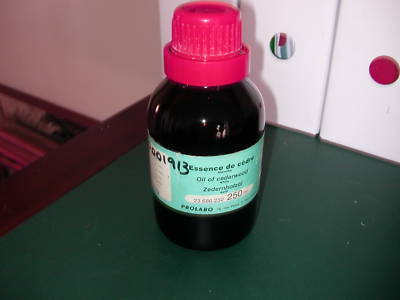Kenosha Reuse Discussion Board > ZION, IL
> Commercial
> Automative
> Refurbished
> Plus Warranty
> New cedarwood oil 250 ml -
New cedarwood oil 250 ml -
This is a new and unopened reagent from Prolabo.
Excellent reagent for microscopy and an absolute gift at this price.
http:// /cgi/display.cgi?item_num=23686.232
Cedar oil was used as the base for paints by the ancient Sumerians. They would grind cobalt compounds in a mortar and pestle to produce a blue pigment. They could obtain green from copper, yellow from lead antimoniate, black from charcoal, and white from gypsum.
Today, cedar oil is often used for its aromatic properties, especially in aromatherapy.
It is also used as an insect repellent.
Cedar oil can also be used to renew the smell of natural cedar furniture.
Although termed cedarwood oils, the most important oils of this group are produced from distilling wood of a number of different junipers and cypresses (Juniperus and Cupressus spp.), rather than true cedars (Cedrus spp.). A cedar leaf oil is distilled from Thuja occidentalis but is not discussed here.
Cedarwood oils each have characteristic woody odours which may change somewhat in the course of drying out. The crude oils are often yellowish or even darker in colour and some, such as Texas cedarwood oil, are quite viscous and deposit crystals on standing. They find use (sometimes after rectification) in a range of fragrance applications such as soap perfumes, household sprays, floor polishes and insecticides. Small quantities are used in microscope work as a clearing oil.
All the cedarwood oils of commerce contain a group of chemically related compounds, the relative proportions of these depending on the plant species from which the oil is obtained. These compounds include cedrol and cedrene, and while they contribute something to the odour of the whole oil they are also valuable to the chemical industry for conversion to other derivatives with fragrance applications. The oils are therefore used both directly and as sources of chemical isolates.
In India, Cedrus deodara oil has been shown to possess insecticidal and antifungal properties and to have some potential for control of fungal deterioration of spices during storage. However, its commercial use for this purpose remains, at present, speculation.
One of three methods of ancient Egyptian embalming practices employs the use of cedar oil. This was a less costly method than the most well known of the ancient Egyptian practices of removing internal organs for separate preservation in canopic jars. The practice "...called for the injection of cedar oil into body cavities without evisceration. The body was laid in natrum or natron - a fixed alkali - for the prescribed period, after which the cedar oil, which had dissolved the soft organs, was released; and the body, its flesh dissolved by the natron, was reduced to preserved skin and bones."
Cedarwood oil is used for the oil immersion objective in light microscopy.
Cedar-wood oil is a mixture of organic compounds considered generally safe by the FDA as a food additive preservative. The oil is used as an anti-bacterial, fungicide. Studies have shown that prolonged exposure to high levels of cedar-wood oil can cause liver and pulmonary toxicity. The EPA does not expect such effects to occur among users of currently registered products because their use and public exposure is a much lower level and more intermittent then those in the case studies. EPA believes there is negligible human environmental risk posed by exposure to registered cedar-wood pesticide or food preservative products if used in properly prescribed manner.

